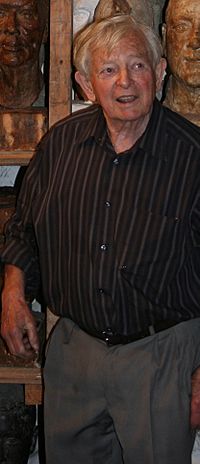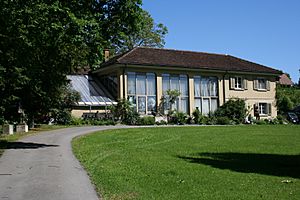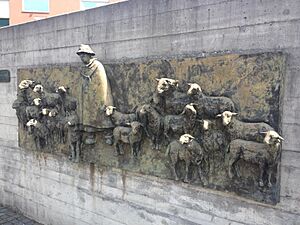Rolf Brem facts for kids
Quick facts for kids
Rolf Brem
|
|
|---|---|

Rolf Brem with several portraits, some of which were at the Great Exhibition in Seville
|
|
| Born | 12 February 1926 |
| Died | 11 April 2014 (aged 88) |
| Nationality | Swiss |
| Education | Art School, Apprenticeship by Karl Geiser |
| Known for | Sculpture, Graphics and Illustration |
| Movement | Realism |
| Awards | Kiefer-Hablützel-Preis, Prize of Art of Lucerne, Prix International de la Médaille in Krakow |
Rolf Brem (born February 12, 1926 – died April 11, 2014) was a talented artist from Switzerland. He was a sculptor, meaning he made statues. He was also an illustrator and a graphic artist. Rolf Brem worked in a town called Meggen, which is near Lake Lucerne.
Contents
Rolf Brem's Life Story
Growing Up and Early Art
Rolf Brem grew up in Lucerne, Switzerland. Many people in his neighborhood had everyday jobs. His father was a hairdresser. But his uncle, Johan, was an artist who worked with metal.
Rolf started making sculptures when he was only seven years old. He used clay to create his first portraits. During World War II, he made many portraits of General Guisan. Some were painted, and some were made from cement. He even sold them to his classmates! He also made portraits of his family and friends.
When Rolf was in secondary school, he began painting with oil colors. But he still loved making clay sculptures. He left school early to focus on his art. He showed his sculptures to a famous artist named Hermann Haller. Haller told Rolf to learn a regular trade first. This way, he would always have a steady income.
Learning to Be an Artist
Rolf Brem decided to become a ceramist, someone who works with clay. But he quickly lost interest. In 1945, he quit and went to art school. While there, he helped a local sculptor named Hans von Matt. After three years, Rolf left art school because he wanted to start working.
He heard about Karl Geiser, a very famous Swiss sculptor. Rolf wrote to Geiser and asked to be his apprentice. In 1948, Rolf Brem started working full-time for Karl Geiser. For the next ten years, Rolf learned a lot in Geiser's studio. He learned how to create clear forms in sculptures. Geiser taught him how to truly see a face to make a good portrait.
Rolf Brem's Art Studios
Rolf Brem had his first own studio in Lucerne from 1946 to 1952. It was in an old house. This studio was very important because he started creating portraits in his own unique style there.
In 1952, he moved to a bigger studio in Lucerne. It used to be a brewery! This new studio had water and electricity. It even had a flat roof where Rolf could make huge drawings. He could now create his own art alongside Geiser's work.
Since 1957, Rolf Brem's main studio has been in Meggen. It's in a beautiful park, inside an old building called St. Charles-Hall. This large studio is always filled with light. Rolf used this studio for over fifty years.
In 1972, Rolf opened a second studio in Mendrisio, in the Italian part of Switzerland. This studio was close to the Perseo Art foundry, where his sculptures were cast into bronze.
Changes in His Art Style
After Karl Geiser passed away, Rolf Brem's art style began to change. His sculptures became less stiff. They started to look more individual and lively.
Rolf Brem's Artworks
Making Portraits
Over sixty years, Rolf Brem created about 400 portraits. Some of them show famous people. These include the flutist James Galway and the author Günter Grass. He also sculpted business leaders like Rainer Gut and Marc Rich. To make a good portrait, the artist and the person being sculpted need to know each other well. Because of this, Rolf became good friends with some of his subjects.
Other Important Works
Between 1965 and 1985, Rolf Brem made many sculptures for churches and graveyards. He created a crucifix for the Church Meggen. He also designed all the inside decorations for the Saint Boniface church in Geneva.
Rolf Brem designed a special coin for Lucerne's 800-year anniversary. In 1975, he won an international award for medals in Kraków, Poland.
After his wife died in 1982, he started sculpting goats. Rolf was fascinated by how tough and stubborn goats are. He studied their bones and drew sketches. Since then, he has sculpted goats eating, sleeping, and scratching themselves.
Exhibition in Seville
In 1992, Rolf Brem was invited to a big art show. It was the Great Exhibition in Seville, Spain. A curator named Harald Szeemann wanted to show Rolf's portraits. A total of 136 of Rolf Brem's portraits were displayed there. They were all placed on a shelf for everyone to see.
How Rolf Brem Created Art
Rolf Brem rarely drew sketches before starting a sculpture. He found it easier to work directly with soft materials. He often got ideas from his daily life. If he saw something interesting, he would try to sculpt it from his imagination. However, for tall figures, he needed a real person to model for him.
He would shape the form using clay, wax, cement, or plasticine. These materials are flexible, allowing him to play with the shape and size.
To make a head, Rolf first built a wooden frame. This stopped the clay from falling down. He would start by shaping a basic head. Then, he would meet with the person he was sculpting several times. Each session lasted about an hour. Rolf found that his concentration was best for about an hour. It usually took four to six meetings to finish a portrait.
When he was close to finishing, he would make a plaster cast. This saved his work and allowed him to work more boldly. Once the portrait was complete and a plaster cast was made, he would take it to Mendrisio. There, it would be cast into bronze, making it a lasting artwork.
See also
 In Spanish: Rolf Brem para niños
In Spanish: Rolf Brem para niños



